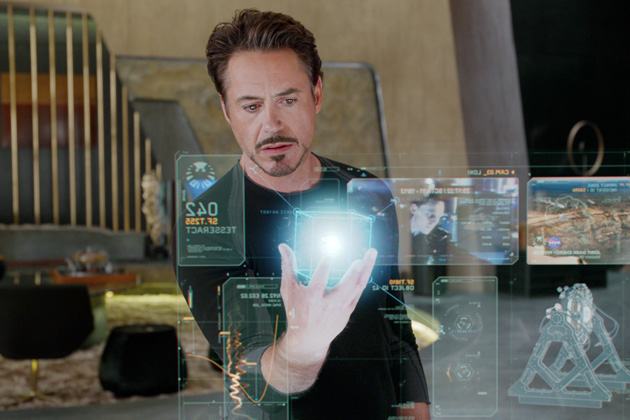Look around your office hallway or college campus and you’ll see people holding interactive panes of glass. Smartphones and tablets, so revolutionary a few years ago, are quickly becoming commodities. Apple (AAPL) is now locked in a fierce patent battle with Samsung over tablet designs—a sure sign that, whoever is right, touchscreens are converging into gadgets that look like everything else.
So as Apple prepares to launch its next iPhone in September, with a slightly bigger screen, here is a prediction—Apple devices will soon project holograms like you’ve never seen. This is not mere speculation, but insight based on Apple’s patents, recent acquisitions, and the business imperative to do something to break free of the tablet clutter.
In November 2010, Apple patented a three-dimensional display system that would “mimic a hologram” without requiring special glasses. The patent narrative is fascinating, noting that one current market gap in screen technology is the ability of a device to project stereoscopic 3D images to multiple viewers at the same time.
Apple proposed an elegant solution: match a forward-facing camera/sensor that tracks the location of different viewers’ eyes, similar to how Microsoft’s (MSFT) Kinect monitors body movements or new digital cameras recognize human faces, with a screen that can send out beams of light at different angles. Voilà! Each eye of each viewer receives a different angle of the image, and suddenly Princess Leia would appear to beam out of R2-D2 and float in the air.
I know what you’re thinking—3D screens have been around for a while, but consumers have not flocked to them. Overall, television sales are in a slump (LCD sales were down 3 percent worldwide in the first quarter after years of 20 percent growth), and consumers who recently upgraded to flat panels did not rush out to buy the 3D versions manufacturers dreamed would goose the market. Even 3D tech that doesn’t require glasses has not sold well; Nintendo (NTDOY) sales of its 3DS gaming device, which floats images without glasses, were so anemic in 2011 that it dropped the price from $250 to $170 just five months after launch.
If 3D has been such a yawn, why would Apple get involved? There are three main reasons.
Apple is the second-mover that makes failed first-mover ideas work. Apple lifted the idea for the mouse from Xerox, streamlined it, coated the rotating ball in rubber so it would be quiet on a desktop, and dropped the price. Apple launched its touchscreen iPhone and iPad years after Microsoft tried to go to market in 2002 with a pen-based Tablet PC. Apple redesigns technology to remove the rough edges, and consumers respond in droves. Toshiba is now selling a 55-inch 3D television in Asia that doesn’t require glasses for viewing the effect. Do you think Apple will let such advances in screen technology pass it by?
Second, Apple’s hologram technology will be different—and completely realistic. The Apple patent states, “Each viewer could be presented … with complete freedom of movement … without the need for special viewing goggles or headgear.”
Read that as the hologram will remain realistic even if you and your friends move around the room, and you won’t look like a doofus watching it. The Apple patent also explains how the monitoring sensor would pick up and replicate ambient lighting in the room—creating, say, a projection of a business colleague floating at your conference table with light from the window gleaming in her hair.
Finally, in perhaps its most unique trick, the Apple hologram system would detect who is watching, and be able to display different images to different people. The patent says “individual observers … can be uniquely identified based upon distinctive personal characteristics (e.g., height, shoulder width, distinctive outline, etc.),” allowing outbound beamed projections to be changed for each observer. This would enable everything from private holograms to personalized advertising. In business video calls, you could project yourself in a suit for the upper executives in the room and a more relaxed view of yourself in jeans for the younger tech hipsters.
Apple must forge a new direction, because not only will its patent lawyers have difficulty claiming rights to all tablet designs, the touchscreen may soon be obsolete.Walt Disney (DIS), not known for being a gadget leader, recently announced its R&D division has developed “swept frequency capacitive sensing” that turns virtually any material into a touchscreen. Called Touché, the system would allow couches, doorknobs, clothing, and even water to sense your movement or finger swipes, making touchscreens irrelevant. If you can type on a tabletop, the need for a tablet may disappear.
Beyond its 3D patent, Apple has acquired 3D modeling businesses such as C3 Technologies and Poly9, both known for building photorealistic images of the world.C3 Technologies, for instance, used declassified military technology and aerial photography to model any potential mountain, building, or home in three dimensions—reportedly accurate to within 6 inches. Apple’s upcoming map apps could be more interesting than you expect.
Apple also has a monetary incentive to chase 3D: True screen differentiation would boost sales of all Apple products. Apple could finally break into the television market and own the living room; holography could unlock revenue streams from business communications, with Apple “reality projection” videoconferencing making Skype look like a telegraph. Apple has been rumored for years to be developing real TV sets, but needs a way to break into the saturated big-screen market. If its holography were to top Toshiba’s design, there surely would be interest.
As tablets become commodities, it’s not hard to predict the design battle will move from hardware to the virtual visual realm. Even Sir Jonathan Ive can take glass panes only so far. I don’t know if an iPhone 5 will hold holograms, but eventually Apple will serve us 3D images—because while anyone can copy a glass tablet, not everyone can make the world float in your hand.
By Ben Kunz on August 07, 2012
